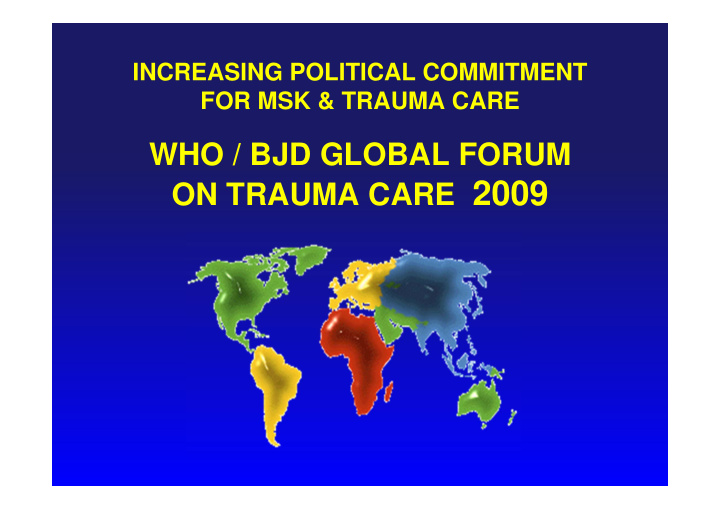



INCREASING POLITICAL COMMITMENT FOR MSK & TRAUMA CARE WHO / BJD GLOBAL FORUM ON TRAUMA CARE 2009
Outline • 1. Overview: history, burden, challenges and gaps • 2. Current progress and Goals • 3. Role of Global Forum on Trauma Care • 4. Next steps, Actions
THE INJURY PYRAMID The millions of deaths that result from injuries represent only a small fraction of those injured. Tens of millions of people suffer injuries that lead to hospitalization, emergency department , general practitioner or other treatment .
Burden of Injury: Deaths • Source: Injuries and Violence: The Facts, WHO, 2010. Available from www.who.int
Spectrum of Injury Control Surveillance Prevention Pre-Hospital Care Hospital Care Acute care Rehabilitation
PERCENT OF ALL SERIOUSLY INJURED (ISS > 9) WHO DIE 80 Percent of injured patients 70 60 63 who expire 50 55 40 30 35 20 10 0 Seattle, USA Monterrey, Mexico Kumasi, Ghana
If we could eliminate these inequities: 80 70 60 63 50 55 40 30 35 20 10 0 USA Mexico Ghana Over 2,000,000 of the 5,800,000 injured people who die each year could be saved.
Spectrum of Trauma Care Pre-Hospital Care Hospital Care Tier 1 Tier 2 First responders Formal EMS Bystanders Ambulance Rehabilitation Facility- Community- based based
CHALLENGES AND GAPS A. Human Resources: Example: Surgeons per 100,000 USA 50 Latin America 7 Africa 0.5 B. Physical Resources (supplies, equipment) Shortages in many essential items, even those that are low cost.
IMPROVEMENTS POSSIBLE despite financial restrictions GNP Health $ Per capita Per capita High income (e.g. USA) $40,000 $5,000 Middle income (Latin America) $4,000 $100 - 500 Low income (Africa, Asia) $300 $10
3. Current progress: Local programs A. Improving existing ambulance service (EMS) Monterrey, Mexico Improve training and EMS infrastructure Mortality: 8.2% to 4.7% B. Innovative programs for areas without formal EMS Northern Iraq / Cambodia Improve first aid capabilities of village volunteers Mortality: 40% to 9% C. Hospital based improvements: Quality Khon Kaen, Thailand: QI program Mortality: 6.1% to 4.4%
3.Current progress: Global WHO/BJD efforts Prehospital Facility based Define basic essential services. Delineate resources necessary to provide essential services to all injured. •Human resources (skills, training, staffing) •Physical resources (equipment, supplies)
Emphasizes simple techniques: Case studies: Getting more out of M & M All WHO regions Preventable death panel reviews All economic levels Corrective action and closing the loop Prehosp, hosp, rehab, system-wide
CONCRET ACTIONS CONCRET ACTIONS
Global Forum on Trauma Care Rio de Janeiro: 28 – 29 October, 2009
Broad Goals of the Forum • Develop a strategy to promote greater political commitment to affordable and sustainable improvements in trauma care. • Promote greater uptake of recommendations of WHA 60.22.
What determines political priority given to different global health issues? Shiffman J . Generating political priority for maternal mortality reduction in 5 developing countries Am J Public Health. 2007;97:796–803. Shiffman J . A social explanation for the rise and fall of global health issues Bull WHO 2009;87:608–613 Shiffman J , Smith S. Generation of political priority for global health initiatives. Lancet 2007; 370: 1370 – 79.
The New England Journal of Medicine n engl j med 360;5 nejm.org January 29, 2009 special article A Surgical Safety Checklist to Reduce Morbidity and Mortality in a Global Population Alex B. Haynes, M.D., M.P.H., Thomas G. Weiser, M.D., M.P.H., William R. Berry, M.D., M.P.H., Stuart R. Lipsitz, Sc.D., Abdel-Hadi S. Breizat, M.D., Ph.D., E. Patchen Dellinger, M.D., Teodoro Herbosa, M.D., Sudhir Joseph, M.S., Pascience L. Kibatala, M.D., Marie Carmela M. Lapitan, M.D., Alan F. Merry, M.B., Ch.B., F.A.N.Z.C.A., F.R.C.A., Krishna Moorthy, M.D., F.R.C.S., Richard K. Reznick, M.D., M.Ed., Bryce Taylor, M.D., and Atul A. Gawande, M.D., M.P.H., for the Safe Surgery Saves Lives Study Group*
UN General Secretary Ban Ki Moon asking all country members to ACT
Conclusions Agreement on WHA 60.22 as foundation for advocacy Concise key messages need refining: – Basic life saving care in the field and rapid transport to a site of definitive care. – Access to adequate, timely, essential care that is life or limb saving at hospitals and clinics. – Access to adequate, essential rehabilitation services for those with disabilities resulting from their injuries . Time to think and reflex to develop tools for advocacy - - Be consistent and use strong and safer strategies to influence the decision makers in Economy to convince them: Trauma is a PRIORITY .
Conclusions • Need for global network to unite different groups and promote advocacy. • Debate on name and topics to encompass – Trauma – Trauma and emergency care – Emergency care – “Trauma” does not resonate with public. • Synergies, but not to directly work on prevention and Core Group leaders creation; Marketing; • Trauma Care Checklist; Communication; Data
BJD Trauma INSTITUTIONS NGOs care PARTNERS � technical support � political support � financial support
Collaborative Efforts
RIO DE RIO DE JANEIRO JANEIRO 11-13 July, 11-13 July, 2013 BJD 2013 BJD
THANK YOU Marcos Musafir
Recommend
More recommend